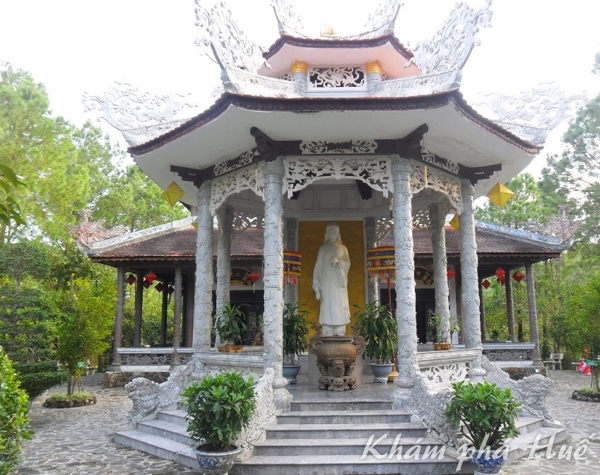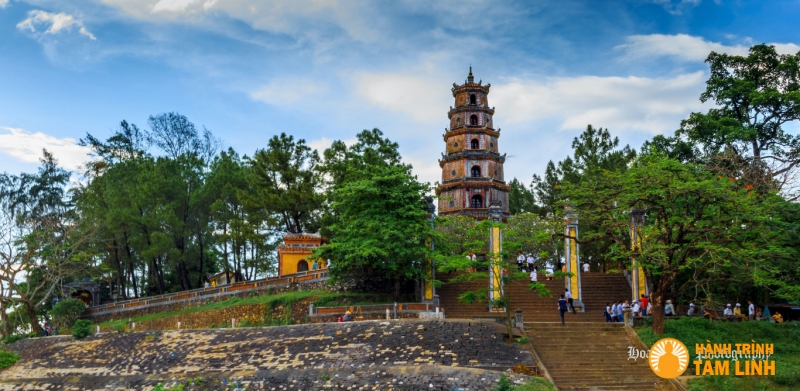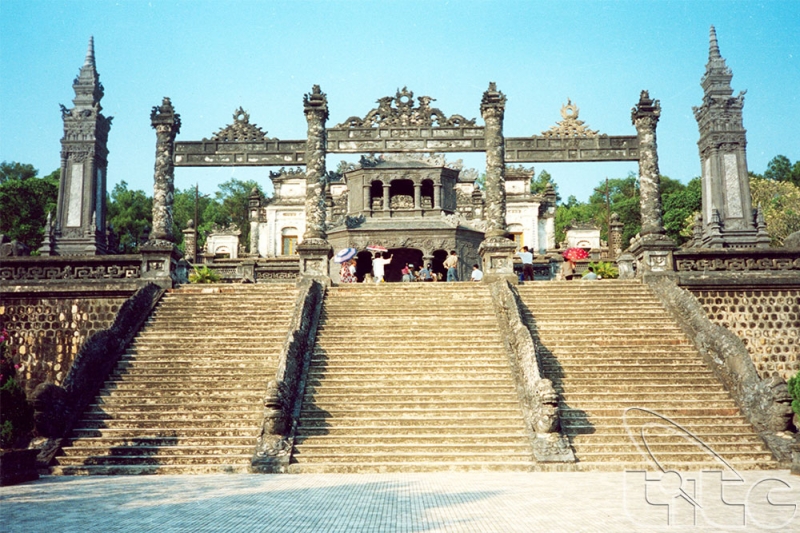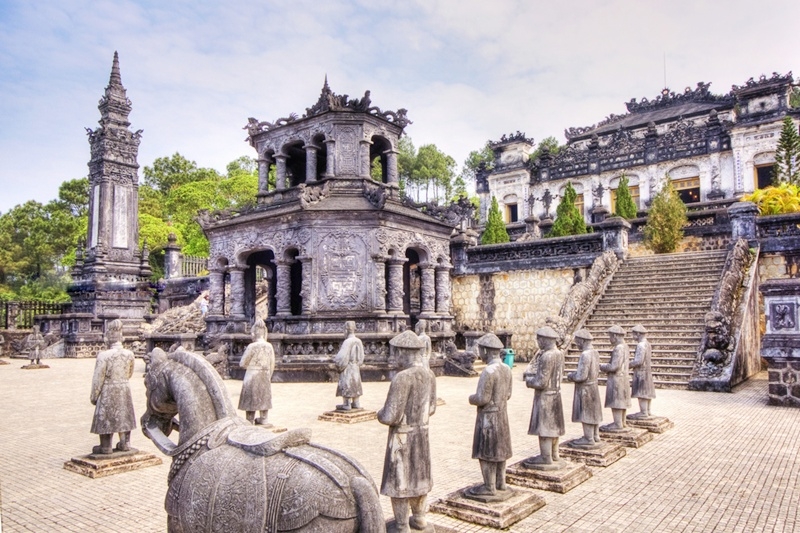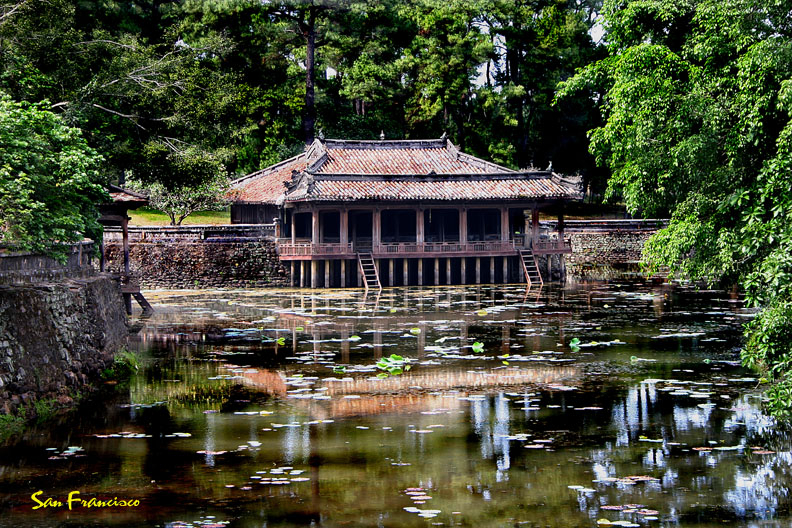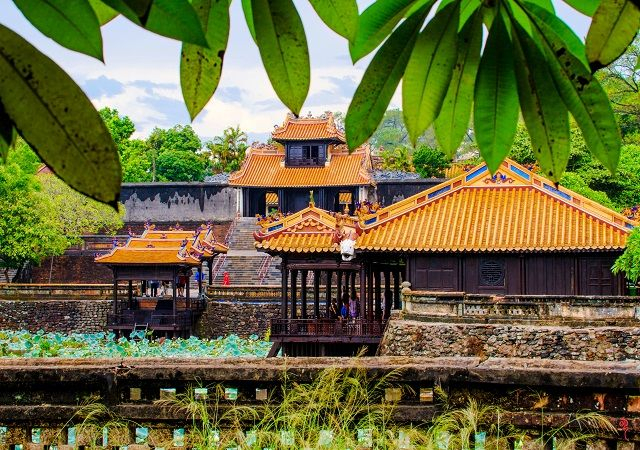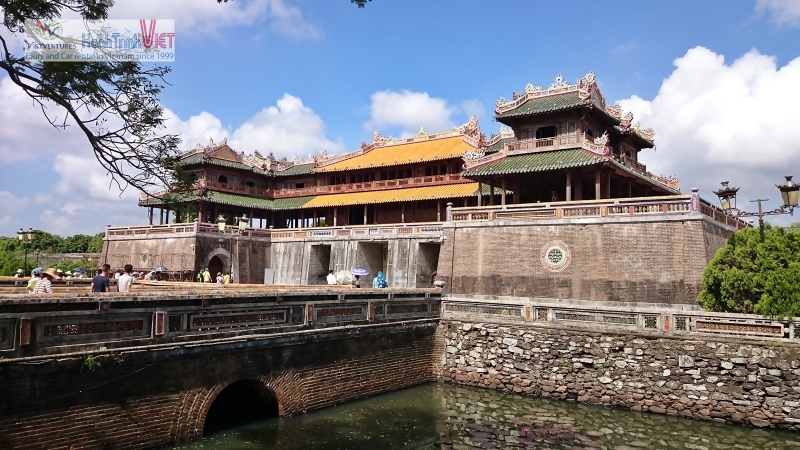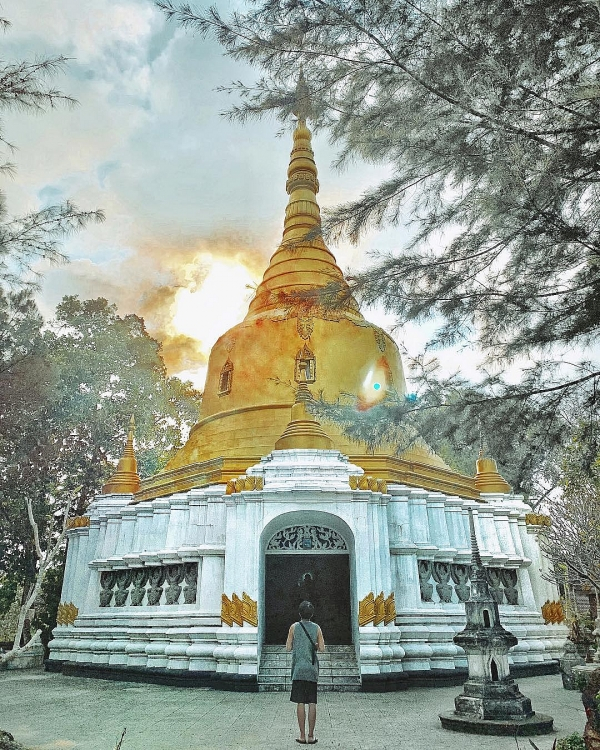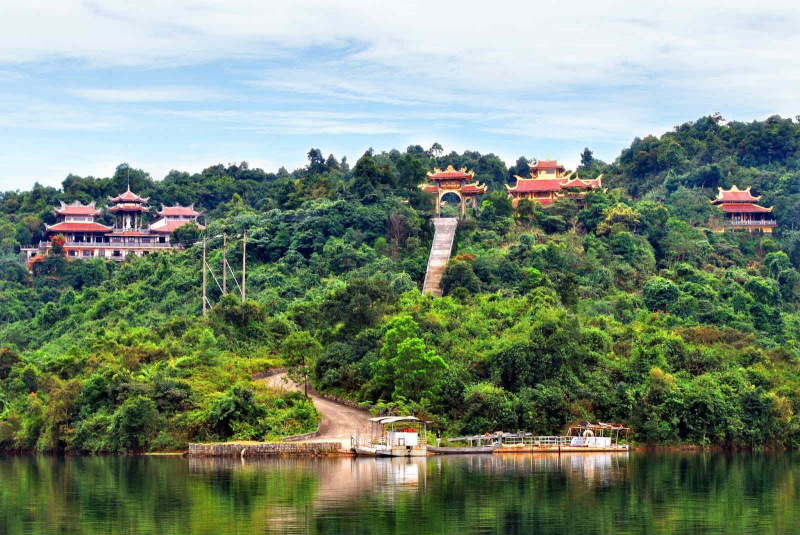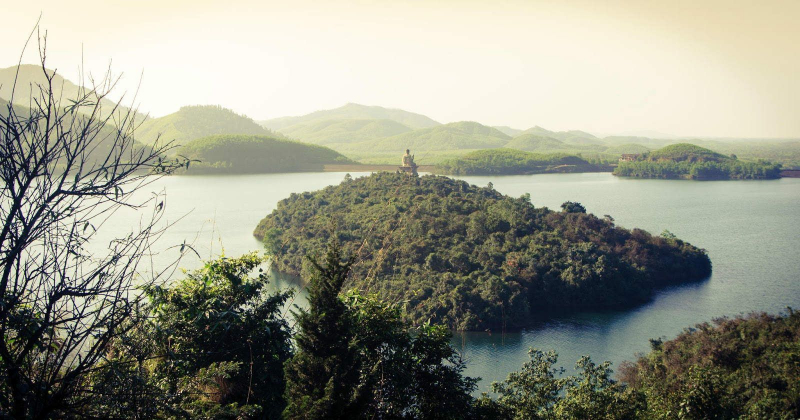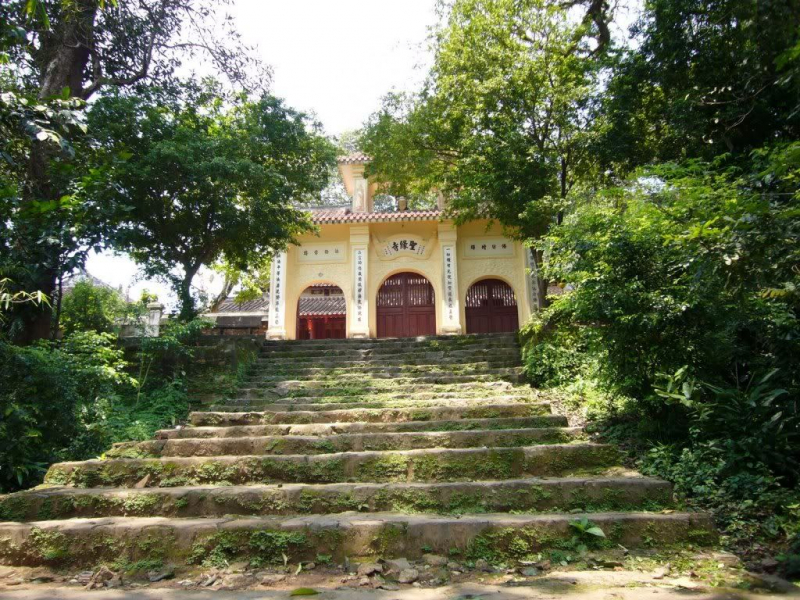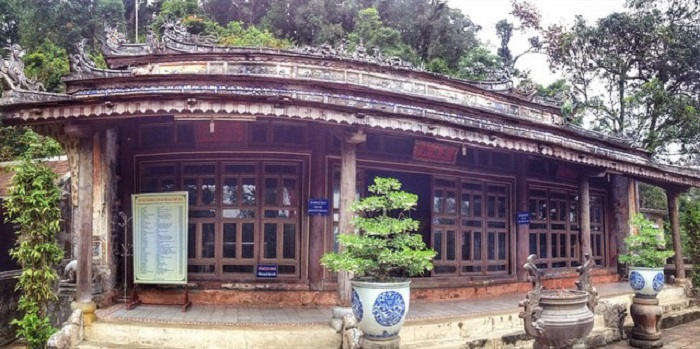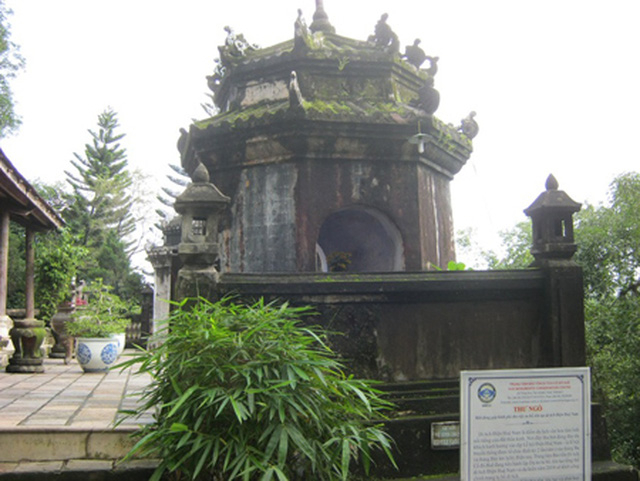Tran Thai Binh Temple – a cultural and spiritual tourist destination
Thai Binh is known as a land of land and spirits under the Tran dynasty, this is the fact that more than 700
Hue – reminds people of nostalgia, reminiscent of the peaceful Perfume River and the purple long dress that is difficult to mix. Hue – the land of the ancient capital associated with national historical events, leaving the present generation with many works of significant historical value. Let’s visit this dream city with Vinlove, discover typical spiritual tourist destinations.
Huyen Tran Cultural Center, also known as Princess Huyen Tran Temple, is located at 151 Thien Thai Street, An Tay Ward, Hue City. The temple has a bit of adventure in it with its Zen-like scenery, but also close-knit nuances from images associated with Buddhism as well as Hue culture.
She was born in 1287 to 1293, when King Tran Nhan Tong abdicated, Crown Prince Tran Thuyen ascended the throne to take the title of Emperor Tran Anh Tong. King Tran Nhan Tong became the supreme emperor and became a monk at Yen Tu mountain. In 1301, Emperor Tran Nhan Tong accepted the invitation, went on a trip to Champa, was warmly received by the Champa king Che Man, and stayed in the Champa palace for nearly 9 months. When leaving, Tran Nhan Tong promised to marry his daughter Huyen Tran to Che Man, although at that time Che Man already had a wife, Queen Tapasi, a Javanese. After that many times Che Man sent messengers to ask about the marriage, but the courtiers of the Tran Dynasty objected, only Van Tuc Vuong Dao Tai and Enter inside commanded Tran Khac Chung to advocate approval.
In 1306, Che Man offered Chau O and Chau Ry as dowries, King Tran Anh Tong agreed to marry Huyen Tran to Che Man. Huyen Tran returned to Chiem Thanh and was crowned Queen Paramecvari. A year later, when the queen had just given birth to Prince Che Da Da, in May 1307, King Che Man died. Emperor Chiem sent an envoy to Dai Viet to report the funeral. According to Chiem custom, when the king died, the queen had to go to the funeral pyre to mourn. King Tran Anh Tong heard the news, sent Tran Khac Chung pretending to visit the funeral, trying to save Huyen Tran. Tran Khac Chung successfully devised a plan, saved Huyen Tran from the boat, and brought Huyen Tran back to Dai Viet by sea. This voyage lasted up to a year and according to Dai Viet Su Ky Toan Thu, Tran Khac Chung had a relationship with the princess.
In August of the year of the Year of the Dead, ie 1308, Huyen Tran returned to Thang Long. According to the decree of Emperor Nhan Tong, the first princess of the Buddhist family in Trau Son mountain – now in Bac Ninh. In 1309, under the seal of the national monk Bao Phat. The princess received the bodhisattva vows and was given the dharma name Huong Trang. At the end of Tan Hoi year 1311, Huong Trang and a former maidservant established a temple at the foot of Tiger Mountain to practice. After that, Am Tranh became Buddha’s temple, ie Nom Son pagoda or also known as Quang Nghiem Tu. She died on the 9th day of the first month of the year Canh Thin, 1340. People around the area mourned and honored her as “God Mother” and built a temple next to Non Son Pagoda. The day she died later every year became the festival day of Huyen Tran Temple on Ngu Phong Mountain in Hue.
In the following dynasties, she was ordained as the guardian god of the country. The King of the Nguyen Dynasty issued a decree to repay the princess “in protecting the country and helping the people, with many inspirations”, raising the rank of monk to “Trai Tinh Trung Dang Than”. To remember the merits of the Princess, the Nguyen Dynasty established the Temple of the Great Emperor in Lich Doi village, Duc ward, Hue city, to worship the founding fathers of the country, including Princess Huyen Tran . Unfortunately, this shrine is no longer present. At the beginning of 2006, Huyen Tran Cultural Center has started construction. A year later, on March 26, 2007, the work was inaugurated on the 700th anniversary of Thuan Hoa – Phu Xuan.
Thien Mu Pagoda is one of the most mentioned beautiful sights in Hue. Not only entering the romantic poems of Hue but also in the verses, Thien Mu is also considered a sacred temple and must-see scenes of any visitor when arriving in the ancient capital. this old. Thien Mu Pagoda (also known as Linh Mu Pagoda) is located on Ha Khe hill, on the north bank of the Perfume River, Kim Long ward. About 5 km west of Hue city center. Built-in 1601 by Lord Tien Nguyen Hoang – the first Nguyen Lord in Dang Trong, Thien Mu Pagoda can be considered as the oldest pagoda in Hue.
Thanks to the rise and golden age of Cochinchina Buddhism, the pagoda was rebuilt on a considerable scale under the reign of Lord Quoc – Nguyen Phuc Chu (1691-1725). In 1710, Lord Quoc cast a Dai Hong Chung bell that weighed over two tons and had an inscription engraved on it. Lord then extended a series of construction projects. Typically, 1714 was the period of greatest expansion in the history of the pagoda, namely Thien Vuong Palace, Dai Hung Palace, Dharma Lecturer, Tang Kinh floor, Sangha room, Zen house… that no longer exists today. Chua Quoc also personally wrote and engraved on a large stele (2.6m high and 1.2m wide) talking about the construction of architectural works here. The beer is placed on the back of a very large stone turtle, the decoration is simple but beautiful.
With its natural beauty and expanded scale since that time, Thien Mu Pagoda has become the most beautiful pagoda in Dang Trong. Through historical events, Thien Mu Pagoda was restored many times during the reign of the Nguyen kings. King Thieu Tri, Minh Mang’s successor, erected Tu Nhan Thap in 1844, which is now known as Phuoc Duyen tower. The tower is 21m high with an octagonal shape and has seven floors, each of which is dedicated to a different Buddha. Standing on the tower, visitors can look at the calm Perfume River and watch the light yachts drifting on the river.
Thien Mu Pagodaranked is one of the 20 most beautiful spots in Hue. Experiencing many expansions and renovations, besides architectural works such as Phuoc Duyen tower, Dai Hung Palace, Dia Tang Palace, Quan Am Palace… with stone stele, bronze bell, Thien Mu Pagoda today is the place. There are many precious antiques in both history and art. The Dharma protector statue, the statue of the Ten Kings, the Maitreya Buddha … or the couplets here have marked the history of a golden age of Thien Mu Pagoda .
Coming to Hue, it is a mistake if tourists do not visit Thien Mu Pagoda . Because over hundreds of years, each architectural work here contains solemnity and is a harmonious combination between human talent and a beautiful natural landscape. Participating in Hue tourism in general, and Thien Mu Pagoda In particular, visitors will be comfortably immersed in their mind drifting along the Perfume River from upstream to downstream to feel a different life in peaceful Hue.
Khai Dinh Tomb in Hue was built on the slopes of Chau Chu mountain, located outside the Citadel, about 11km to the south. Khai Dinh Tomb (Ng Lang) has become the symbol, the pinnacle of the art of shaping crockery and glass.
Compared to the size of the mausoleums of other Nguyen kings, Ung Lang has a much smaller area (117m x 48.5m) but it is very laborious and time consuming. In terms of architecture, the mausoleum is also set apart from the traditional architecture of the Nguyen Dynasty because of its novelty, welcome, and is the result of a mixture of many different architectural schools such as Buddhism, Hinduism, Roman, Gothique … in the cultural interference of East-West of the time and personality of King Khai Dinh.
Overall, the mausoleum is a rectangular floating block rising up high, with 127 steps:- The entrance to visit Khai Dinh Tomb passes 37 steps, with the ramparts covered with huge dragons, on the courtyard there are two rows of Left – Huu Tong. Similarly, on both sides, two layers of matches are built, eight roofs, but the trusses are made of reinforced cement.- 29 more steps to reach the courtyard level. On both sides of the yard, each side has 2 rows of military statues looking at the middle of the yard, especially 6 pairs of Linh Tuc guard statues, made of rare stone materials and have a good mood. – Thien Dinh Palace is in the highest position. and is the main architecture of the mausoleum, where the talents of the workers are vividly displayed.
The entire interior of the 3 naves is elaborately decorated with porcelain mosaic art. Along with the paintings on the wall, the floor is tiled with floral glaze and on the ceiling is a beautiful painting of “Cuu Long Hidden Van”. In particular, the inside is impregnated with soft and elegant curves as if made of silk, but is actually a reinforced concrete block weighing nearly 1 ton. Underneath the temple is a bronze statue of King Khai Dinh cast in France in 1920. The entire decoration inside Thien Dinh Palace not only reflects the architectural values, representing the image of Khai Dinh Tomb, but also mentions to the idea of the work and the will of the king.
Although condemned in many ways, the tomb of King Khai Dinh in Hue is truly a valuable work in terms of art and architecture, enriching and diversifying the complex of tombs of the ancient capital, becoming a tourist attraction.
Tu Duc Tomb (also known as Khiem Lang) is a historical relic in the complex of Hue monuments that was recognized by UNESCO as a world cultural heritage on December 11, 1993. This is the burial place of the 4th emperor of the Nguyen Dynasty, King Tu Duc (Nguyen Phuc Hong Nham), who reigned for 36 years from 1847-1883, is the longest-reigning king of the Nguyen Dynasty. Tu Duc Tomb is a complex of architectural works located in a narrow valley in Duong Xuan Thuong village, Cu Chanh (old) canton, now Thuong Ba village, Thuy Xuan ward, Hue city. At first, the mausoleum was named Van Nien Co (萬年基), after the Chay Voi Rebellion, King Tu Duc changed its name to Khiem Cung (謙宮). After the king’s death, the mausoleum was renamed Khiem Lang (謙陵).
At the beginning of construction, King Tu Duc named the project Van Nien Co, with the desire to last forever. However, due to the hard work of collecting and constructing the mausoleum, he was brutally beaten by the mandarins, which was the source of the Chay Voi rebellion of the people who built the mausoleum. Although the uprising was suppressed, due to this incident, the king had to change the name Van Nien Co to Khiem Cung and write a confession to apologize.
In 1864, the mausoleum was built with 50,000 soldiers participating. In 1866, Van Nien Co changed its name to Khiem Cung. In 1873 Khiem Cung was completed.
This is considered the most beautiful mausoleum in the system of mausoleums of the Nguyen Dynasty kings. Tu Duc Tomb has sophisticated architecture, charming landscape, and is one of the most beautiful mausoleums of the Nguyen kings. Panorama of Tu Duc Tomblike a large park, integrated with nature. There are no straight and angular lines, but instead a harmony and winding as if completely immersed in nature, even though the work is completely created by human hands. In general, this architecture is full of solemnity and high art, harmoniously structured between undulating hills, lush trees, green pine forests, melodious lakes flowing into a peaceful and poetic scene. and very beautiful, subtly melancholy and elegant as the sensitive soul, love of nature and art of the filial and filial king, known as the “poet king”.
With soft lines, the Tomb of Tu Duc looks like a beautiful painting and is listed as one of the most beautiful works of the 19th century.
Hue Citadel (common name for the Imperial Citadel and the Forbidden City of Hue) is the most famous tourist attraction of Thua Thien Hue province, with a complex of once-golden royal palace architecture.
Hue Citadel was the living place and administrative center of the last feudal court of Vietnam. Starting with King Gia Long, 13 kings of the Nguyen royal family lived continuously until the end of the dynasty after King Bao Dai’s announcement of abdication in August 1945. Hue Citadel has 4 gates that were announced. It is located on 4 sides with the main gate located in the south is Ngo Mon, in the north is Hoa Binh gate, in the west is Chuong Duc gate and in the east is Hien Nhon gate. In front of Ngo Mon is the Hue Monument and the square, where cultural and artistic activities take place on the occasion of Tet. The Imperial Citadel and the entire inner palace system adhere to the principle of “left man and woman”, “left van and martial arts”.
Hue Citadel is divided into areas:
Tu Dam Pagoda was built around 1695 by Venerable Minh Hoang – Tu Dung (born in China, belonging to the 34th Zen line, Lam Te sect) around 1695. The pagoda was originally named An Ton with the meaning of taking the mind transmission. as the motto of the temple. In 1703, Zen Master Minh Hoang – Tu Dung restored and repaired the pagoda. Also at this time, Lord Nguyen Phuc Chu – the 6th Nguyen Lord of the Cochinchina government ordained the pagoda as “Sac Tu An Ton Tu”. Like other temples in Vietnam, Tu Dam PagodaIt has a combination of traditional and modern architectural art lines. The temple is located in a spacious and airy space surrounded by many ornamental plants. The architecture of the pagoda consists of three parts: the three-way gate, the main pagoda, and the Hoi house. The three-way gate (the type of gate with three paths commonly found in Vietnamese traditional pagodas) is tall, wide, with elegant tiled roofs. Behind the gate, there is a bodhi tree that gives shade all year round. It is known that this is the Bodhi tree extracted from the Bodhi tree where Buddha attained enlightenment, donated by Mrs. Karpeies – the president of the Buddhist Association of Dharma, invited from India to Vietnam and planted in 1936. The temple yard is large and paved. The stone is flat, airy, with enough room to gather thousands of people.
The main pagoda consists of the front hall, the main hall, and the ancestral house. The forecourt was built on a granite foundation, 1.5m high; The roof is built in an ancient style, giving the temple a higher shape than usual. On the roof banks and on the roof of the pagoda are pairs of curved, soft and symmetrical dragons emerging on the rows of yin and yang tiles that look very balanced, harmonious and beautiful. Under the ancient roof are embossed statues of the Buddha, neatly arranged on cast frames. Along the front pillars are long couplets with sharp carvings. On the left and right sides of the street, there are two empty bell towers. The Buddha hall is decorated with dignity, in the middle is a statue of Buddha Shakyamuni sitting majestically on a lotus, on both sides there are reliefs of two Bodhisattvas Manjushri and Pho Hien. Tu Dam PagodaBecause of the unique worship, the arrangement and worship in the temple is somewhat simple compared to other temples in Hue. To the right of the main hall is the guest house and the monk’s room. In front of the guesthouse, there is a small flower garden, in the middle of the garden is a bust of layman Tam Minh, who has made many contributions to the temple and in the movement to revive and develop Buddhism in Vietnam.
Tu Dam Pagoda regularly welcomes the religious leaders of Buddhism in other countries, scholars, intellectuals and many delegations of tourists and Buddhists at home and abroad to visit and worship Buddha. Coming here, in addition to learning about the history of the temple, visitors can also admire the beautiful architecture and landscape in the temple.
Thien Lam Pagoda , also known as the “Standing Buddha – Reclining Buddha” pagoda, is located on Quang Te hill, Thuy Xuan ward, Hue city. It was built in 1960 by the Venerable Ho Nhan with the original shape of just a small cup. Up to now, the pagoda is a complex consisting of many architectural works such as statues, tomb towers, Buddha towers, monks’ houses… in many different locations. And Thien Lam Pagoda is the only ancient temple of the Theravada sect inherited from the traditional architecture of Buddhist countries in the world, very different from the temples in Hue.
Hardly any temple in Hue has the image of Buddha Shakyamuni as rich as at Thien Lam Pagoda. The temple has a statue of Buddha Shakyamuni everywhere. At the fork at the foot of Quang Te hill, visitors will see a statue of “The World-Honored One begging for alms” about 8 meters high. On the way to the temple grounds, visitors will see the Buddha statue of Nirvana lying more than 7m long on the left side. It is from these two statues that Thien Lam Pagoda is also known as “the temple of the standing Buddha – the reclining Buddha”. Entering the temple, at the end of the campus on the left is a white stupa with golden peaks soaring, majestic but elegant in the sky. The stupa has 2 parts: the lower floor is the main hall; The upper floor houses the relics of Buddha Shakyamuni and holy monks.
Truc Lam – Bach Ma Zen Monastery is a spiritual tourism destination in the ancient capital that you should come when you want to find a famous place for spiritual tourism. Truc Lam Zen Monastery is a Zen monastery of Truc Lam Yen Tu Zen sect founded by Most Venerable Master Thuong Thanh Ha Tu, located at the foot of Bach Ma mountain, in the middle of Truoi lake, with silent blue water in Loc commune. Hoa, Phu Loc district gives guests the feeling of peace, relaxation, and harmony with fresh nature.
Visitors take a ferry in the middle of Truoi Lake to go to Truc Lam Zen Monastery. Truc Lam Bach Ma Monastery is hidden in blue smoke like a beautiful looming watercolor painting. Looking far away, the Zen Monastery shows the beauty of a green peninsula in the middle of the mountains, reflecting on the clear water. To get to the monastery, visitors need to go through 172 steps – as a test of the sincerity of visitors in the land of Buddha.
The stillness radiates from the mountains and forests, the green trees stretch the same message, the smoke clouds embrace the top of the hill, the sound of birds answering each other, all seem to blow into the hearts of visitors a feeling of relaxation and peace. peace to escape from the world that Truc Lam Zen Monastery brings to visitors. In addition, at Truc Lam Bach Ma Zen Monastery, the temple bells echo in all four directions, blending with the sacred singing of birds and sometimes the sounds of wild animals creating an elegant and quiet space.
Thanh Duyen Pagoda is the next place in spiritual tourist destination for tourists when coming to Hue. Thanh Duyen Pagoda was built on Tuy Van mountain – a small mountain near Tu Hien estuary, now in Vinh Hien commune, Phu Loc district.
The pagoda was built in the second half of the seventeenth century, under Lord Nguyen Phuc Tan, and then rebuilt by Lord Nguyen Phuc Chu in Nham Than year. And it was repaired by King Minh Mang in 1825 and named Thanh Duyen Pagoda in 1836 with the addition of Dai Tu Cac and Dieu Ngu Tower.
Thanh Duyen Pagoda was built in the typical Nguyen architectural style “coincidentally with snails”, with the layout of Thanh Duyen pagoda – The Dai Tu – Dieu Ngu Tower. Thanh Duyen Pagoda includes a pagoda with three compartments and two wings, with a la citadel. Behind the pagoda is Dai Tu Cac, a three-room structure surrounded by ritual gates and la citadel. At the top of the mountain is the 3-story Dieu Ngu Tower, about 12m high. Behind the tower, there is a small communal house, in front of the communal house there is a dragon-horse screen, surrounded by a la citadel. The main temple has 3 altars and 2 court cases to worship Buddha Tam The, Quan Am, 18 Arhats…, especially bronze statue of 18 Arhat heads.
Hon Chen Palace is the last name in the spiritual tourist destinations when coming to Hue that Vinlove would like to recommend to you. Hon Chen Palace, a religious relic and famous scenic spot in the complex of relics of the ancient capital of Hue, is located in Hai Cat village, Huong Tho commune, Huong Tra district.
Hon Chen Palace is a cluster of relics including about 10 different large and small architectural works, all located halfway up the slope of Ngoc Tran mountain, facing the Perfume River, hidden under tall trees. Hon Chen Palace includes Minh Kinh Dai located in the middle; on the right is the house of Quan Cu, Trinh Cat Vien, and the Holy Temple; On the left is the Marble Palace, the altar of the mandarins, the cave worshiping Mr. Ho, Ngoai Canh am. At the edge of the river, there is also Thuy Phu Am.
Minh Kinh Dai is the place where the ceremony is held at Hon Chen Palace. Minh Kinh Dai is divided into 3 arcs, in order from highest to lowest: First – Second – Third. Minh Kinh Dai is a typical architectural work that takes the image of a phoenix to decorate. On the rooftops, the phoenix is represented by sophisticated crockery mosaic art, making visitors feel that the phoenixes come from the mountains and forests, signaling good omens for this sacred land.
Hon Chen Palace is not only a historical and religious relic but also a unique landscape and cultural attraction. Therefore, this place attracts a large number of tourists to visit, especially during the festivals of March and July of the lunar calendar every year.
From the historical and spiritual architectural works, Hue increasingly attracts a large number of tourists to visit its charming land. Try once to come to Hue, come to the ancient capital for nostalgia, to find the most poetic feeling.
